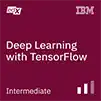5 weeks
2–4 hours per week
Self-paced
Progress at your own speed
Free
Optional upgrade available
There is one session available:
53,364 already enrolled! After a course session ends, it will be archivedOpens in a new tab.
Starts Nov 22
Deep Learning with Tensorflow
Awards

At a glance
- Institution: IBM
- Subject: Data Analysis & Statistics
- Level: Intermediate
- Prerequisites:
- Python & Jupyter notebooks
- Machine Learning concepts
- Deep Learning concepts
- Language: English
- Video Transcript: English
- Associated programs:
- Professional Certificate in Deep Learning
- Associated skills:Nodes (Networking), Numerical Analysis, TensorFlow, Artificial Neural Networks, Unstructured Data, Deep Learning, Dataflow, Curve Fitting, Machine Learning
Who can take this course?
Unfortunately, learners residing in one or more of the following countries or regions will not be able to register for this course: Iran, Cuba and the Crimea region of Ukraine. While edX has sought licenses from the U.S. Office of Foreign Assets Control (OFAC) to offer our courses to learners in these countries and regions, the licenses we have received are not broad enough to allow us to offer this course in all locations. edX truly regrets that U.S. sanctions prevent us from offering all of our courses to everyone, no matter where they live.This course is part of Deep Learning Professional Certificate Program
Learn moreExpert instruction
6 skill-building courses
Self-paced
Progress at your own speed
7 months
2 - 4 hours per week
Interested in this course for your business or team?
Train your employees in the most in-demand topics, with edX For Business.


